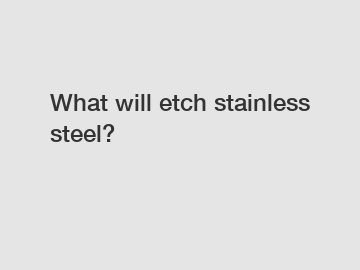Jan. 07, 2024
Hardware
What will etch stainless steel? This is a common question for those who work with stainless steel and need to know how to remove unwanted materials or engrave patterns onto the surface. The answer lies in the chemical properties of stainless steel and the materials that can effectively react with it.
Stainless steel is known for its resistance to corrosion and staining due to the presence of chromium in its composition. Chromium forms a thin layer of oxide on the surface of stainless steel, which acts as a protective barrier against external elements. However, this layer can be compromised, leading to etching.
One of the most common materials that can etch stainless steel is hydrochloric acid (HCl). When stainless steel comes into contact with HCl, it undergoes a reaction known as acid etching. The acid breaks down the protective oxide layer, exposing the underlying steel to further reactions. This results in a pattern or engraving on the stainless steel surface.

The etching process can vary depending on the concentration and duration of the acid exposure. Higher concentrations of hydrochloric acid and longer exposure times will result in deeper etching and more noticeable patterns. It is important to note that etching stainless steel with hydrochloric acid should be done with caution and proper safety measures, as HCl is corrosive and can be harmful if not handled properly.
Another material that can etch stainless steel is ferric chloride (FeCl3). Similar to hydrochloric acid, ferric chloride reacts with the protective oxide layer on stainless steel, leading to etching. Ferric chloride is commonly used in the electronics industry for etching copper, but it can also be effective for etching stainless steel.
The etching process of stainless steel has various applications and implications. It can be used for decorative purposes, such as creating intricate patterns or designs on stainless steel surfaces. Additionally, etching can be used to remove unwanted materials or stains from stainless steel, restoring its appearance.
In the field of engineering and manufacturing, etching stainless steel can be useful for marking parts or components with identification numbers, logos, or instructions. This facilitates traceability and improves the overall organization of production processes.
In conclusion, hydrochloric acid and ferric chloride are common materials that can etch stainless steel. Through the process of acid etching, these substances react with the protective oxide layer on stainless steel, creating patterns or engravings on the surface. The ability to etch stainless steel has various applications ranging from decorative purposes to marking and identification in engineering and manufacturing. However, it is important to handle these etching materials with caution and follow proper safety measures.
Want more information on Black Bead Blasted Stainless Steel Sheet, PVD Coated Stainless Steel Manufacturer, Antique Color Stainless Steel Sheet? Feel free to contact us.
If you are interested in sending in a Guest Blogger Submission,welcome to write for us!
All Comments ( 0 )